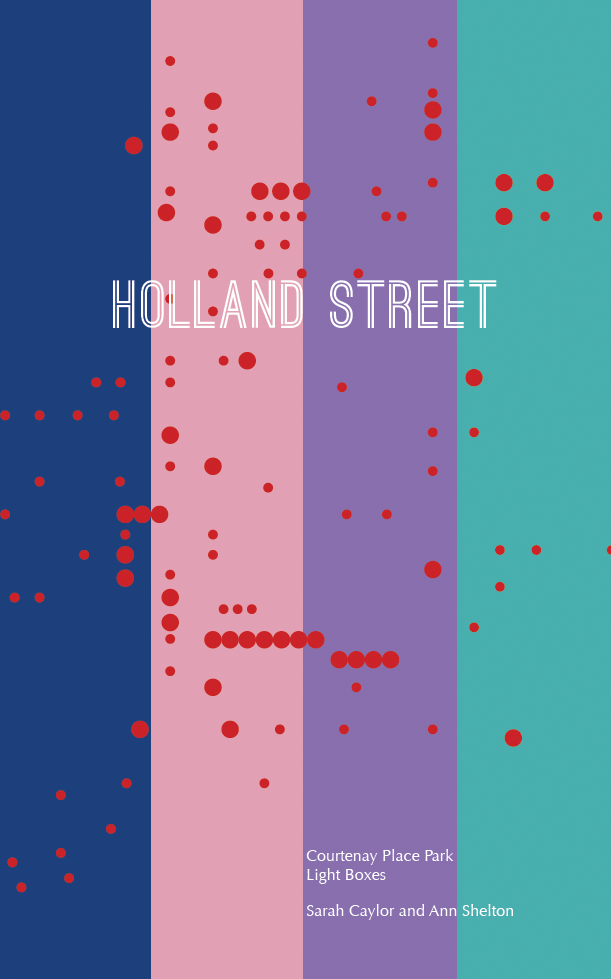HOLLAND STREET
Sarah Caylor
Ann Shelton
Published on the occasion of the exhibition
Holland Street, by Sarah Caylor and Ann Shelton
Courtenay Place Park Light Boxes
Wellington, New Zealand
15 August – 2 December 2013
 Taking as its starting point two nineteenth-century events – London’s cholera outbreak of 1854 and Wellington’s typhoid epidemic of 1890-2 – Holland Street recalls a world where disease was thought to travel through miasma (noxious air) and bacteria were believed to be as real as “Hydras, and Gorgons, and Chimeras Dire”. Holland Street utilises differing visual approaches to map critical sites related to these two disease events, one marking the birth of modern epidemiology, and another resulting in the construction of Wellington’s current sewerage system.
Taking as its starting point two nineteenth-century events – London’s cholera outbreak of 1854 and Wellington’s typhoid epidemic of 1890-2 – Holland Street recalls a world where disease was thought to travel through miasma (noxious air) and bacteria were believed to be as real as “Hydras, and Gorgons, and Chimeras Dire”. Holland Street utilises differing visual approaches to map critical sites related to these two disease events, one marking the birth of modern epidemiology, and another resulting in the construction of Wellington’s current sewerage system.
In telling this story, Holland Street places the spectre of human waste at center stage. The work addresses the cultural, ideological and medical contexts and consequences of an epidemic that took place in the environs of Courtney Place Park. In imposing a visual interruption of the streetscape, Holland Street encourages us to envisage an otherwise invisible conceptual and material infrastructure, tracing its roots back to the nineteenth-century and forward to the present.
Sarah Caylor is a designer, writer and curator whose work deals in the intersections of sustainability, social justice, and history. She has produced exhibitions, film series and symposia at several institutions in the United States including the Nasher Art Museum, Solomon R. Guggenheim Museum (New York), Des Moines Art Center, Portland Art Museum, and Oregon Historical Society. Caylor holds a BA in History (Lewis and Clark College), an MA in Art History (University of California, Riverside), was a Helena Rubenstein Fellow for the Whitney Independent Study Program in Critical Studies (New York), and completed coursework towards a PhD in Art History (Duke University) before leaving to pursue a career in the green building industry, working in Communications for Cook+Fox, New York’s leading sustainable architecture firm. Since arriving in Wellington three years ago, Caylor has co-convened the AAANZ (Art Association of Australia and New Zealand) Annual Conference, and become a PhD Candidate at Victoria University of Wellington, School of Design where she also guest lectures and tutors. Caylor’s doctoral research, of which Holland Street is a part, examines the cultural history of sewage, seeking alternative ways of making that history visible.
Ann Shelton (MFA, The University of British Columbia, Vancouver, Canada) was born in Timaru, New Zealand. Shelton’s large-scale, hyper real photographic works interrogate the unfixed histories embedded in place and located in archival collections. Operating at the nexus of conceptual & documentary modes, they investigate the social, political & historical contexts that inform readings of the landscape and its contents. Recent curated exhibitions include The City of Gold and Lead for the Sarjeant Art Gallery Whanganui, in a forest curated by Donna West-Brett and Tony Nolan for the Australian Center for Photography, Sydney, a way of calling at Linden Centre for Contemporary Arts, Melbourne, curated by Melissa Keys, and Dark Sky at The Adam Art Gallery, Wellington, curated by Geoffrey Batchen with Christina Barton. Shelton is Chair of Enjoy Public Art Gallery, Wellington’s longest running artist run space and Director Undergraduate Studies in Photography at The School of Fine Arts, Massey University, Wellington.
RIM BOOKS
ISBN 978-0-473-25725-5
2013
35p, colour plates
Exhibition catalogue – essay and design by Sarah Caylor
RRP $16
For all wholesale orders and requests info@rimbooks.com
